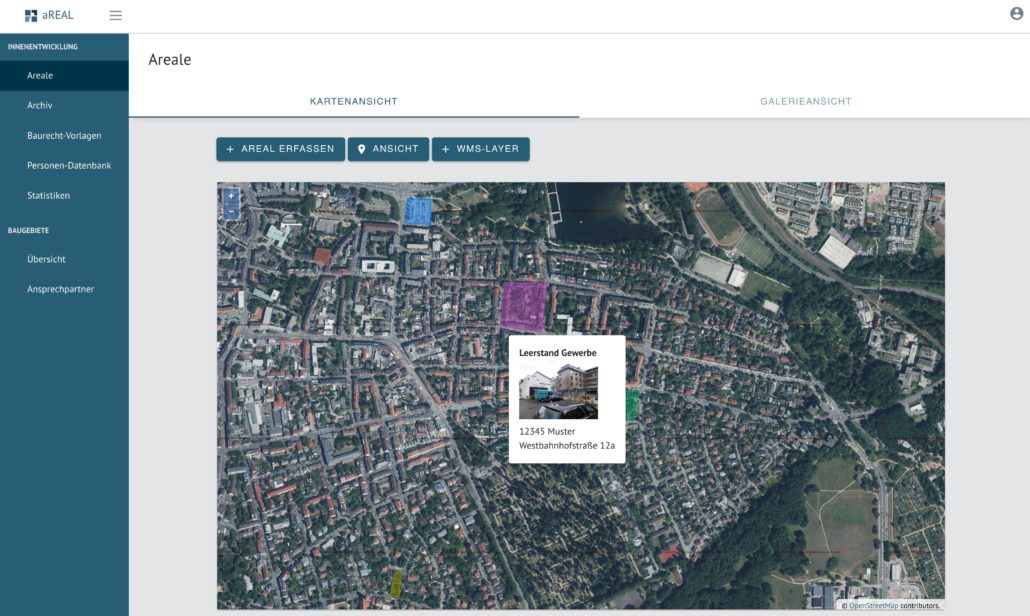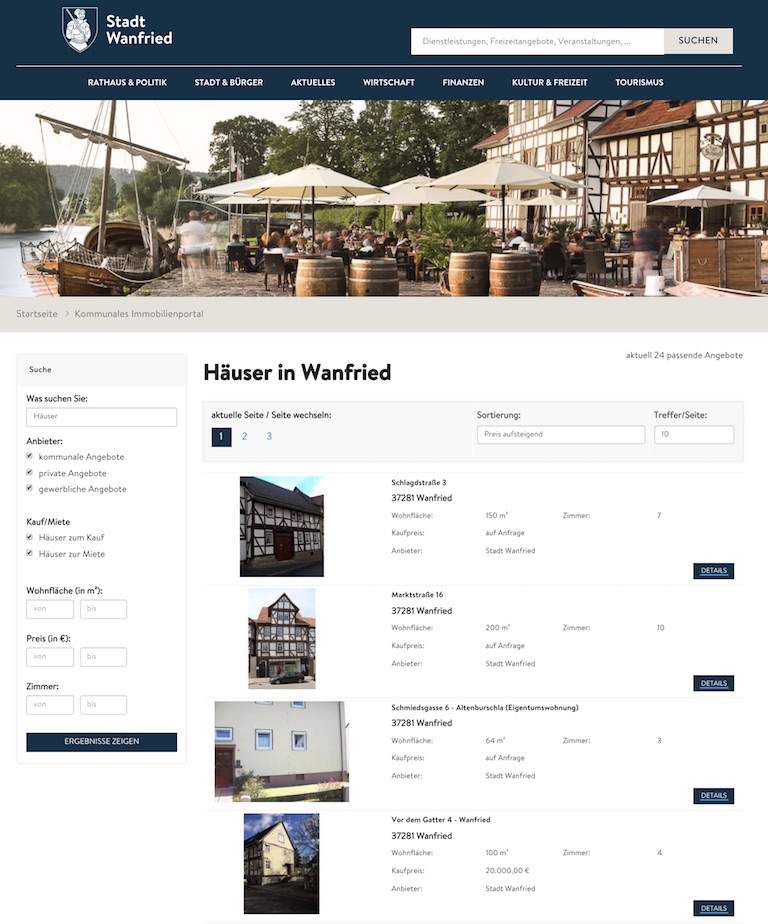BEST-PRACTICE-EXAMPLES
Find out on this page how other local authorities, business development agencies or regional associations successfully work with the products of immovativ GmbH.
#Hanau #Inner-urban-development
Find out how the city of Hanau successfully identified, digitised and activated inner city development potential with the urban development software aREAL® and KIP.
#Wanfried #Real-Estate-Portal
Find out how the city of Wanfried has gained over 100 new residents in recent years, even in a structurally weak region, by operating its own real estate exchange.
#SpessartKraft #Vacancy
Read how the nine member municipalities of the municipal alliance SpessartKraft in Bavaria digitally place their vacant buildings on the real estate market.
#Darmstadt #search-engine-optimization
Find out how the science city of Darmstadt is well placed in Google with relevant search terms for the business location.
#HLG #building-land-marketing
Read why the Hessische Landgesellschaft (HLG) relies on the municipal real estate platform (KIP) for the online presentation of residential and commercial areas.
#Main-Kinzig-District #aREAL®
Find out why the Main-Kinzig district equips all municipalities in the district with the interior development software aREAL® and at the same time conducts active location marketing.
Inner urban development in Hanau
Within the framework of the project “INNENSTATTAUSSEN”, 63 areas with a total area of 17 ha were identified in the core city of Hanau alone on the basis of a knowledge workshop.
Real estate management data on the sites were collected and recorded using the product aREAL. After the city had positioned itself with regard to a possible subsequent use of the sites, an owner dialogue was initiated with the support of KIP | Potenzialflächen. With the consent of the owners, the inner development potential was published in the KIP Hanau. In this way, appropriate investors could be found.
In the meantime, 13 fallow areas in Hanau have been put to new use. In the process, attention was paid to sustainable urban development. A total of around 650 residential units have been created to date.
Starting position
- For the start of the project there were several occasions. On the one hand, the land consumption for new residential, commercial and traffic areas did not decrease to the extent desired by economic and ecological objectives, on the other hand, there is a great shortage of land in the Rhine-Main area in particular due to the increase in the population.
- In Hanau, too, the number of people looking for space, whether for residential or commercial purposes, has risen sharply. The city took part in the pilot project in order to be able to submit adequate offers to prospective property buyers and to push ahead with the marketing of the properties.
- With the amendment of the new BauGB in 2013, interior potentials will become a matter of consideration in urban land-use planning in the future. It is therefore necessary for each municipality to catalogue its available areas or to maintain the existing database.
Aims
- The overriding objectives of the pilot project were to develop previously unused, underused and vacant areas within the inner city area and to secure the location of the city of Hanau.
- The focus was on sustainable urban development and maintaining the value of the real estate portfolio.
- The political committees were to be sensitised to the topic of “inner development”.
Realization
- In the beginning there was a workshop of the Deutsche Gesellschaft für Innenentwicklung mbH together with the city’s specialist offices. On the one hand, categories of potential areas were defined and on the other hand, areas were identified from the “knowledge pool” of the participants.
- A second step was the detailed recording of the areas in a database. The KIP module Potential Areas was used for this purpose. The mobile application supported the recording process, the modern internet-based database allows a variety of data analyses.
- Further building blocks followed:
- the definition of internal administrative processes,
- the development of urban development concepts and the definition of the “talents” of the areas,
- the design of a dialogue with the owners of the land plots.
- In a so-called “Quickcheck” it was worked out why the areas were not offered on the real estate market so far, where possible problems lie and in which period an activation is conceivable.
- With the consent of the owners, the first areas were published in a separate register “Potential Areas” in the municipal real estate portal of the city of Hanau (KIP) and thus made available to the real estate market.
REAL ESTATE EXCHANGE WANFRIED
As a small town in a structurally weak region, Wanfried has for many years been actively fighting against the inner-local vacancy of real estate. In particular, the old half-timbered houses of the former harbour town on the Werra require special attention.
In Wanfried, a group of citizens was founded more than 10 years ago to market vacant properties in Wanfried and its districts. At the same time, the citizens’ group advises buyers on the restoration and maintenance of the properties. They even opened their own model half-timbered house.
Supported by the citizens’ group, the city administration has obtained a complete overview of vacant houses, apartments and commercial properties. With KIP | real estate portal the objects were registered and published. The real estate exchange was integrated directly into the city’s homepage using modern API technologies and a corresponding design adaptation.
The result was a very good ranking in the search engines. Thus the search terms “apartment rent Wanfried” or “house buy Wanfried” reach at present TOP 3 places in Google. The city administration is pleased – so could be settled in the past 5 years far over 100 new citizens in Wanfried. Formerly dilapidated buildings have been restored and turned into true gems.
Vacancy activation in the municipal alliance SpessartKraft
“Inner development before outer development” – this is the key objective under which the nine municipalities of SpessartKraft Dammbach, Eschau, Heimbuchenthal, Leidersbach, Mespelbrunn, Mönchberg, Röllbach, Rothenbuch and Weibersbrunn have joined forces to further develop space and vacancy management in their municipalities. One project from the “Living – Housing – Working” field of action is the activation of vacant real estate and building gaps.
The municipalities have created a groundbreaking platform on which they market real estate and land together: the municipal real estate portal SpessartKraft. On this platform all objects of the alliance municipalities available for sale are represented in clear manner. The aim of this real estate portal is to reduce vacancies, if not eliminate them, and to give vacant land a new use by selling it.
The project was financed and accompanied by the Amt für Ländliche Entwicklung Unterfranken, the Bayerisches Staatsministerium des Innern, für Sport und Integration and the government of Unterfranken. The site was technically implemented with the product KIP from immovativ GmbH.
Location marketing in Darmstadt
Today, the search for suitable commercial space and real estate is carried out almost exclusively via the Internet. The most frequent entrance is thereby the search machine Google. For municipalities, which would like to market their trade location, it is therefore expressed important to be present here.
The operation of a local real estate portal with KIP can be an important step to be found optimally with the municipal offers. In combination with active location marketing, which also includes, for example, appropriate search engine optimisation, local authorities can be found by relevant stakeholders on Google.
The business development department of the science city Darmstadt uses this potential and publishes available commercial areas and commercial properties in the city exclusively on KIP. By means of a corresponding optimization, the portal was able to position itself at the top of Google’s list of search terms for “commercial space in Darmstadt” – and that without paid ads.
HLG construction site marketing
The Hessische Landgesellschaft mbH – short “HLG” – was founded in 1972 and is the state trust agency for rural land readjustment in Hesse. The non-profit settlement company with headquarters in Kassel is majority-owned by the state.
HLG currently manages several hundred building land developments in Hesse. For several years now, HLG has been placing its offers on kip.net in order to reach in particular local building site interested parties.
Last year, around 1,500,000 exposé calls were generated for the approximately 2,000 building sites that HLG markets in almost 300 projects with interactive property plans.
Digital model project Main-Kinzig-District
The Main-Kinzig district is breaking new ground in order not to designate new industrial estates all the time, but to make use of existing inner-local development potential in the sense of sustainable land management. In a digital model project with the character of a lighthouse for the state of Hesse, the existing commercial space potential is captured, digitized and activated using the interior development software aREAL®.
In a first step, the still available commercial areas in the industrial estates in the district will be digitized and presented in the municipal real estate portal (KIP) of the respective municipality and district as an interactive property plan. This online presentation enables companies and investors to obtain a comprehensive overview of available areas for new locations in a map display at any time.
In a second step, the experts at immovativ GmbH convert already existing surveys on intra-local development potentials into a uniform data format and make them available to the respective business development agencies in a database. Using a mobile iPad application, the data can then be quickly and easily updated by the municipalities and further brownfields, commercial real estate and vacancies can be recorded.















